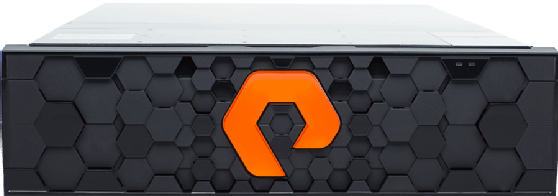
chris - Fotolia
Pure Storage FlashArray//X goes pure NVMe
The third generation of Pure FlashArray//X includes a new 1 TB capacity DirectFlash module. Pure said the rollout completes its integration of NVMe flash on all arrays.
Pure Storage is cutting the cord on traditional flash drives to go whole-hog on NVMe with its new FlashArray//X flagship system.
All models of the new Pure Storage FlashArray//X run the vendor's NVMe-based DirectFlash Modules instead of traditional solid-state drives (SSDs). Pure claims the use of its custom flash modules and second-generation Intel Cascade Lake processors can bump the speed of FlashArray//X 25% over previous versions of the SAN array.
The latest Pure Storage FlashArray//XR3 is the seventh generation of its flagship storage array. It is the third generation since Pure's decision in 2017 to switch to an NVMe over Fabrics architecture. Early versions of the SAN array used off-the-shelf SSDs with iSCSI and Fibre Channel connectivity. Pure vice president of strategy Matt Kixmoeller said the vendor will eventually discontinue support for SAS and SATA on FlashArray, although customers can still buy the older version FlashArrays with those drives for now.
Pure also introduced a 1 TB Pure DirectFlash Module to extend NVMe across the low end of the product range with its latest launch.
Version 5.3 of Pure's Purity FA deepens integration with major public clouds and adds host-based encryption to the storage array. The host-to-array encryption performs data reduction and re-encrypts the data close to the application.

Pure customers: prepare to transition from SATA
Until now, Pure embedded DirectFlash on higher capacity FlashArray//X50, X70 and X90 models, but shipped lower capacity XR10 and XR20 arrays with SAS SSDs. DirectFlash places raw NAND on blades that connect via PCI Express to chip-based controller software. Pure initially designed DirectFlash for use with its FlashBlade NAS and has phased in the NVMe cards on FlashArray.
Pure's capacity-based FlashArray//C systems use a different DirectFlash module. FlashArray//C also includes lower-cost quad-level-cell (QLC) NAND SSDs for backup, test/dev and other non-production use cases.
DirectFlash memory cards are also available in 2.2 TB, 4.5 TB, 9 TB and 18.3 TB raw capacities. Pure Storage FlashArray also accepts custom DirectMemory storage class memory, based on Intel Optane-branded 3D XPoint memory, to facilitate read caching.
The Pure Storage FlashArray//X product family includes the X10, X20, X50, X70 and X90, which range from 55 TB to 3 PB of raw capacity. Use cases for the storage include analytics, hybrid cloud and database optimization, among others.
Steve McDowell, a senior analyst for storage and data center technologies at Moor Insights & Strategy in Austin, Texas, said Pure Storage is taking an aggressive approach by going all in on NVMe and jettisoning SATA.
"That allows Pure to deliver a more predictable and scalable performance, because you don't have to worry about the vagaries of [devices] attached to the SATA bus," McDowell said.
Pure Storage said it DirectFlash is written to support existing SAS and SATA deployments, but the vendor is trying to wean customers off the older drive technology.
"This is the final phase-in of our DirectFlash architecture," Kixmoeller said. "We've brought NVMe across the entire product line as we continue to transition away from SSDs across our product portfolio."
Pure Storage as a Service catching on
According to its latest financials, Pure racked up $428.4 million last quarter, with a record $323 million coming from cloud and data-management software. Cloud revenue includes sales of Pure Storage running in hybrid clouds. Pure said it picked up three new major financial-services firms during the quarter.
Pure last year launched Pure Storage as a Service, which provides enterprise block, file and object storage as a pay-per-use service. Customers can also subscribe to the Pure Evergreen program and receive a free controller upgrade every three years, an initiative Pure rolled out to help customers avoid the typical hardware refresh cycle.
"We think our commitment to upgradeability sets us apart from our competition," Kixmoeller said. "Many of our competitors have shipped next-generation devices that are completely incompatible with the arrays they were selling just a few years ago."
The new Pure Storage FlashArray//X platform competes with NVMe-based systems from competitors such as Dell EMC, Hewlett Packard Enterprise (HPE) and NetApp. These vendors are also selling storage as a cloud service to help data centers reduce upfront capital costs. HPE was an early entrant in the game with HPE GreenLake to allow its users to buy servers and storage by the drink, with plans to make all its products and services available this way by 2022.
Last year, Dell Technologies launched Dell Tech on Demand to make all its hardware available with as-a-service pricing and NetApp added NetApp Keystone to its hybrid cloud Data Fabric.
McDowell said the decision to fully adopt an NVMe media on Pure Storage FlashArray//X sets it up to introduce hardware-driven performance enhancements in Purity 6. The next version of the Pure operating system is expected this year.
"We don't know what Purity 6 is yet, but it's certainly going to rely on the new hardware features Pure is adding, both for compute and storage. I'm anxious to see what that delivers," McDowell said.





